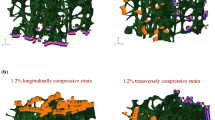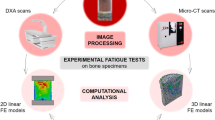Abstract
The microarchitecture and alignment of trabecular bone adapts to the particular mechanical milieu applied to it. Due to this anisotropic mechanical property, measurement orientation has to be taken into consideration when assessing trabecular bone quality and fracture risk prediction. Quantitative ultrasound (QUS) has demonstrated the ability in predicting the principal structural orientation (PSO) of trabecular bone. Although the QUS prediction for PSO is very close to that of \(\upmu \)CT, certain angle differences still exist. It remains unknown whether this angle difference can induce significant differences in mechanical properties or not. The objective of this study was to evaluate the mechanical properties in different PSOs predicted using different methods, QUS and \(\upmu \)CT, thus to investigate the ability of QUS as a means to predict the PSO of trabecular bone noninvasively. By validating the ability of QUS to predict the PSO of trabecular bone, it is beneficial for future QUS applications because QUS measurements in the PSO can provide information more correlated with the mechanical properties than with other orientations. In this study, seven trabecular bone balls from distal bovine femurs were used to generate finite element models based on the 3-dimensional \(\upmu \)CT images. Uniaxial compressive loading was performed on the bone ball models in the finite element analysis (FEA) in six different orientations (three anatomical orientations, two PSOs predicted by QUS and the longest vector of mean intercept length (MIL) tensor calculated by \(\upmu \)CT). The stiffness was calculated based on the reaction force of the bone balls under loading, and the von Mises stress results showed that both the mechanical properties in the PSOs predicted by QUS are significantly higher than the anatomical orientations and comparatively close to the longest vector of MIL tensor. The stiffness in the PSOs predicted by QUS is also highly correlated with the stiffness in the MIL tensor orientation (ATTmax vs. MIL, \(R^{2}\) = 0.98, \(p<001\); UVmax vs. MIL, \(R^{2}\) = 0.92, \(p<001\)). These results were validated by in vitro mechanical testing on the bone ball samples. This study demonstrates that the PSO of trabecular bone predicted by QUS has an equally strong apparent stiffness with the orientation predicted by \(\upmu \)CT.









Similar content being viewed by others
References
Ashman RB, Corin JD, Turner CH (1987) Elastic properties of cancellous bone: measurement by an ultrasonic technique. J Biomech 20:979–986
Ashman RB, Rho JY (1988) Elastic modulus of trabecular bone material. J Biomech 21:177–181
Bevill G, Eswaran SK, Gupta A, Papadopoulos P, Keaveny TM (2006) Influence of bone volume fraction and architecture on computed large-deformation failure mechanisms in human trabecular bone. Bone 39:1218–1225
Biewener AA, Fazzalari NL, Konieczynski DD, Baudinette RV (1996) Adaptive changes in trabecular architecture in relation to functional strain patterns and disuse. Bone 19:1–8
Burghardt AJ, Link TM, Majumdar S (2011) High-resolution computed tomography for clinical imaging of bone microarchitecture. Clin Orthop Relat Res 469:2179–2193
Burr DB, Milgrom C, Fyhrie D, Forwood M, Nyska M, Finestone A, Hoshaw S, Saiag E, Simkin A (1996) In vivo measurement of human tibial strains during vigorous activity. Bone 18:405–410
Burr DB, Turner CH, Naick P, Forwood MR, Ambrosius W, Hasan MS, Pidaparti R (1998) Does microdamage accumulation affect the mechanical properties of bone? J Biomech 31:337–345
Cardoso L, Cowin SC (2011) Fabric dependence of quasi-waves in anisotropic porous media. J Acoust Soc Am 129:3302–3316
Cardoso L, Cowin SC (2012) Role of structural anisotropy of biological tissues in poroelastic wave propagation. Mech Mater 44:174–188
Cardoso L, Teboul F, Sedel L, Oddou C, Meunier A (2003) In vitro acoustic waves propagation in human and bovine cancellous bone. J Bone Miner Res 18:1803–1812
Cody DD, Gross GJ, Hou FJ, Spencer HJ, Goldstein SA, Fyhrie DP (1999) Femoral strength is better predicted by finite element models than QCT and DXA. J Biomech 32:1013–1020
Cowin SC, Cardoso L (2011) Fabric dependence of wave propagation in anisotropic porous media. Biomech Model Mechanobiol 10:39–65
Eswaran SK, Fields AJ, Nagarathnam P, Keaveny TM (2009) Multi-scale modeling of the human vertebral body: comparison of micro-CT based high-resolution and continuum-level models. Pac Symp Biocomput 2009: 293–303
Gefen A, Seliktar R (2004) Comparison of the trabecular architecture and the isostatic stress flow in the human calcaneus. Med Eng Phys 26:119–129
Gluer CC (1997) Quantitative ultrasound techniques for the assessment of osteoporosis: expert agreement on current status. The International Quantitative Ultrasound Consensus Group. J Bone Miner Res 12:1280–1288
Haiat G, Sasso M, Naili S, Matsukawa M (2008) Ultrasonic velocity dispersion in bovine cortical bone: an experimental study. J Acoust Soc Am 124:1811–1821
Han SM, Rho JY (1998) Dependence of broadband ultrasound attenuation on the elastic anisotropy of trabecular bone. Proc Inst Mech Eng H 212:223–227
Hosokawa A (2006) Ultrasonic pulse waves in cancellous bone analyzed by finite-difference time-domain methods. Ultrasonics 44(Suppl 1):e227–e231
Hosokawa A (2009) Numerical analysis of variability in ultrasound propagation properties induced by trabecular microstructure in cancellous bone. IEEE Trans Ultrason Ferroelectr Freq Control 56:738–747
Hosokawa A (2010) Effect of porosity distribution in the propagation direction on ultrasound waves through cancellous bone. IEEE Trans Ultrason Ferroelectr Freq Control 57:1320–1328
Hosokawa A (2011a) Numerical investigation of ultrasound refraction caused by oblique orientation of trabecular network in cancellous bone. IEEE Trans Ultrason Ferroelectr Freq Control 58:1389–1396
Hosokawa A (2011b) Numerical investigation of ultrasound refraction caused by oblique orientation of trabecular network in cancellous bone. IEEE Trans Ultrason Ferroelectr Freq Control 58: 1389–1396
Hosokawa A, Otani T (1997) Ultrasonic wave propagation in bovine cancellous bone. J Acoust Soc Am 101:558–562
Hosokawa A, Otani T (1998) Acoustic anisotropy in bovine cancellous bone. J Acoust Soc Am 103:2718–2722
Isaksson H, Nagao S, MaŁkiewicz M, Julkunen P, Nowak R, Jurvelin JS (2010) Precision of nanoindentation protocols for measurement of viscoelasticity in cortical and trabecular bone. J Biomech 43:2410–2417
Keaveny TM (2010) Biomechanical computed tomography-noninvasive bone strength analysis using clinical computed tomography scans. Ann N Y Acad Sci 1192:57–65
Kim D-G, Hunt C, Zauel R, Fyhrie D, Yeni Y (2007) The effect of regional variations of the trabecular bone properties on the compressive strength of human vertebral bodies. Ann Biomed Eng 35:1907–1913
Krug R, Burghardt AJ, Majumdar S, Link TM (2010) High-resolution imaging techniques for the assessment of osteoporosis. Radiol Clin N Am 48:601–621
Langton CM, Palmer SB, Porter RW (1984) The measurement of broadband ultrasonic attenuation in cancellous bone. Eng Med 13:89–91
Lee KI, Hughes ER, Humphrey VF, Leighton TG, Choi MJ (2007) Empirical angle-dependent Biot and MBA models for acoustic anisotropy in cancellous bone. Phys Med Biol 52:59–73
Lin L, Cheng J, Lin W, Qin YX (2012) Prediction of trabecular bone principal structural orientation using quantitative ultrasound scanning. J Biomech 45:1790–1795
Lin W, Mittra E, Qin YX (2006) Determination of ultrasound phase velocity in trabecular bone using time dependent phase tracking technique. J Biomech Eng 128:24–29
Link TM (2012) Osteoporosis imaging: state of the art and advanced imaging. Radiology 263:3–17
Liu XS, Bevill G, Keaveny TM, Sajda P, Guo XE (2009) Micromechanical analyses of vertebral trabecular bone based on individual trabeculae segmentation of plates and rods. J Biomech 42:249–256
Martin RB, Burr DB, Sharkey NA (1998) Skeletal tissue mechanics. Springer, New York
Mizuno K, Matsukawa M, Otani T, Laugier P, Padilla F (2009) Propagation of two longitudinal waves in human cancellous bone: an in vitro study. J Acoust Soc Am 125:3460–3466
Mizuno K, Matsukawa M, Otani T, Takada M, Mano I, Tsujimoto T (2008) Effects of structural anisotropy of cancellous bone on speed of ultrasonic fast waves in the bovine femur. IEEE Trans Ultrason Ferroelectr Freq Control 55:1480–1487
Mizuno K, Somiya H, Kubo T, Matsukawa M, Otani T, Tsujimoto T (2010) Influence of cancellous bone microstructure on two ultrasonic wave propagations in bovine femur: an in vitro study. J Acoust Soc Am 128:3181–3189
NIH (2000) Osteoporosis prevention, diagnosis, and therapy. NIH Consens State 17:1–45
Njeh CF, Boivin CM, Langton CM (1997) The role of ultrasound in the assessment of osteoporosis: a review. Osteoporos Int 7:7–22
Pidaparti RM, Turner CH (1997) Cancellous bone architecture: advantages of nonorthogonal trabecular alignment under multidirectional joint loading. J Biomech 30:979–983
Qin Y-X, Xia Y, Lin W, Mittra E, Rubin C, Gruber B (2007) Noninvasive ultrasound imaging for bone quality assessment using scanning confocal acoustic diagnosis, \({\mu }\)CT, DXA measurements, and mechanical testing. In: Zhang D (ed) Medical biometrics. Springer, Berlin, pp 216–223
Rubin CT, Lanyon LE (1984) Dynamic strain similarity in vertebrates; an alternative to allometric limb bone scaling. J Theor Biol 107:321–327
Serra-Hsu F, Cheng J, Lynch T, Qin YX (2011) Evaluation of a pulsed phase-locked loop system for noninvasive tracking of bone deformation under loading with finite element and strain analysis. Physiol Meas 32:1301–1313
Tommasini SM, Trinward A, Acerbo AS, De Carlo F, Miller LM, Judex S (2012) Changes in intracortical microporosities induced by pharmaceutical treatment of osteoporosis as detected by high resolution micro-CT. Bone 50:596–604
Wald MJ, Magland JF, Rajapakse CS, Bhagat YA, Wehrli FW (2011) Predicting trabecular bone elastic properties from measures of bone volume fraction and fabric on the basis of micromagnetic resonance images. Magn Reson Med 68:463–473
Whitehouse WJ (1974) The quantitative morphology of anisotropic trabecular bone. J Microsc 101:153–168
Wirtz DC, Schiffers N, Pandorf T, Radermacher K, Weichert D, Forst R (2000) Critical evaluation of known bone material properties to realize anisotropic FE-simulation of the proximal femur. J Biomech 33:1325–1330
Wolff J (1896) The law of bone remodeling. Springer, Berlin
Xia Y, Lin W, Qin YX (2007) Bone surface topology mapping and its role in trabecular bone quality assessment using scanning confocal ultrasound. Osteoporos Int 18:905–913
Yamamoto T, Otani T, Hagino H, Katagiri H, Okano T, Mano I, Teshima R (2009) Measurement of human trabecular bone by novel ultrasonic bone densitometry based on fast and slow waves. Osteoporos Int 20:1215–1224
Yeni YN, Zelman EA, Divine GW, Kim D-G, Fyhrie DP (2008) Trabecular shear stress amplification and variability in human vertebral cancellous bone: Relationship with age, gender, spine level and trabecular architecture. Bone 42:591–596
Acknowledgments
This work is kindly supported by the National Space Biomedical Research Institute through NASA Cooperative Agreement NCC 9-58, NIH (AR52379 & AR61821), and NYSTAR.
Conflict of interest
There is no conflict of interest for all authors.
Author information
Authors and Affiliations
Corresponding author
Rights and permissions
About this article
Cite this article
Lin, L., Oon, H.Y., Lin, W. et al. Principal trabecular structural orientation predicted by quantitative ultrasound is strongly correlated with \(\upmu \)FEA determined anisotropic apparent stiffness. Biomech Model Mechanobiol 13, 961–971 (2014). https://doi.org/10.1007/s10237-013-0547-3
Received:
Accepted:
Published:
Issue Date:
DOI: https://doi.org/10.1007/s10237-013-0547-3




